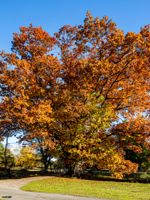Mon-Fri 9am - 5pm Mountain time
Northern Red Oak vs Black Locust
Quercus rubra
Robinia pseudoacacia
Northern Red Oak is a medium-sized deciduous tree. It is fast-growing (for an oak tree) and is used primarily in lawns, parks, golf courses, street-side plantings, and commercial areas. Northern Red Oak's fall color is spectacular.
In open spaces, it has a short, massive trunk and an extensive crown. In forests Northern Red Oak grows with a tall columnar bole and small rounded head.
We are one of the only nurseries growing this tree.
Check out some video of the spectacular fall colour on our Northern Red Oak seedlings just before harvest on our YouTube Channel.
Note: Most Oak species can be considered toxic for many animals.
Black Locust is an attractive tree. Its distinctive leaves are made of about a dozen bright green leaflets. It also notable for its fragrant white flowers, which smell of citrus.
Black Locust can grow in many situations, but prefers dry areas with lots of sun. It is robust and is an excellent choice for establishing shade in dry, open areas.
Important note: Much of the Black Locust is toxic to humans and livestock, including seeds, bark, and leaves.

